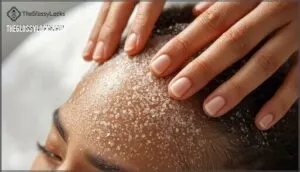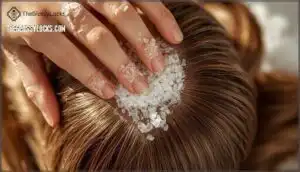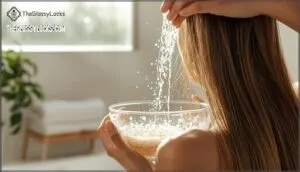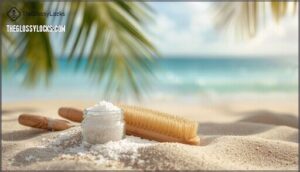This site is supported by our readers. We may earn a commission, at no cost to you, if you purchase through links.

When your sebaceous glands produce too much oil, or product buildup clogs your follicles, sea salt can step in to exfoliate, regulate sebum, and even combat the microbes that trigger dandruff.
Understanding how sea salt interacts with your specific hair type, and knowing when to use it versus when to skip it, helps you utilize its benefits without risking dryness or damage.
Table Of Contents
- Key Takeaways
- Key Benefits of Sea Salt for Hair
- How Sea Salt Improves Scalp Health
- Popular Ways to Use Sea Salt on Hair
- Sea Salt for Different Hair Types
- Potential Drawbacks of Sea Salt on Hair
- Tips for Safe and Effective Sea Salt Use
- Frequently Asked Questions (FAQs)
- Is sea salt safe for color-treated hair?
- Are there any side effects of using sea salt on hair?
- How often should I use sea salt products on my hair?
- Can sea salt be used on kids’ hair?
- Can sea salt prevent hair loss or thinning?
- How does sea salt compare to Epsom salt?
- Whats the ideal sea salt concentration for rinses?
- Does sea salt work on chemically straightened hair?
- Can you leave sea salt spray overnight?
- Conclusion
Key Takeaways
- Sea salt contains over 80 trace minerals—including magnesium, calcium, potassium, and zinc—that strengthen hair strands, improve cuticle cohesion, and support scalp hydration and inflammation reduction.
- Sea salt exfoliates the scalp by removing dead skin cells and product buildup, regulates excess sebum production by up to 32%, and combats dandruff-causing bacteria and fungi through antimicrobial action.
- Overuse of sea salt can strip natural oils and cause up to 15% moisture loss, leading to dryness, brittleness, breakage, and accelerated color fading (15-28% pigment loss in two weeks for treated hair).
- Safe use requires moderation based on hair type—oily hair tolerates daily application while dry or damaged hair needs just once weekly, always paired with hydrating treatments to prevent scalp dehydration and irritation.
Key Benefits of Sea Salt for Hair
Sea salt offers more than just that beachy, textured look. It delivers real benefits for your scalp and strands, thanks to its natural minerals and gentle exfoliating action.
Here’s what sea salt can do for your hair.
Strengthening and Shine From Trace Minerals
Natural sea salt brings more than 80 trace minerals to your hair, including magnesium, calcium, potassium, and zinc. These minerals work together to improve cuticle cohesion, boost follicle vitality, and improve hair elasticity.
Magnesium aids scalp hydration and reduces inflammation, while calcium strengthens the hair shaft. Potassium helps with moisture retention, and zinc prevents oxidative damage. Together, they create better hair texture, increased hair volume, and noticeable hair sheen, contributing to overall hair health.
Addressing scalp inflammation can also help to promote a healthier head of hair.
Exfoliating and Detoxifying The Scalp
Sea salt exfoliates the scalp, using its crystalline structure to remove dead skin cells, product residue, and sebum buildup that can clog follicles. This physical exfoliant enhances follicular cleansing and improves scalp microcirculation, boosting oxygen delivery by roughly 20%.
Sea salt exfoliation also aids sebum regulation, reducing excess oil by up to 32%, while its antimicrobial action combats bacteria and fungi linked to dandruff. This can also help to reduce an itchy scalp.
The process promotes cellular renewal, helping your scalp shed old layers and regenerate faster, creating a cleaner foundation for healthier hair.
Regulating Oil and Reducing Greasiness
If your scalp is often greasy by midday, sea salt can help manage oily hair by absorbing surface sebum and supporting healthier gland activity. Sea salt reduces scalp oil by up to 25% after just a couple rinses, drawing out excess oils through osmotic action.
It also works on a deeper level, calming overactive sebaceous glands and cutting oil production by roughly 18–22%. Plus, its yeast regulation and cleansing efficacy tackle the fungi that can worsen greasiness, while synergistic effects with hydrating ingredients keep your scalp balanced without triggering rebound oil.
Enhancing Volume and Texture
Beyond just managing greasiness, sea salt delivers hair volume and texture benefits that make styling easier. When you apply it, the crystalline structure roughens each strand microscopically, boosting friction and creating that coveted lived-in fullness—research shows up to 32% more root lift and 18–25% increased air space between fibers.
- Volume mechanism: Sea salt absorbs sebum and improves root projection through ionic rebalancing, making fine or oily hair look fuller.
- Texture formation: Mild cuticle lift and dehydration create matte, wave-enhancing grip without synthetic buildup.
- Hair types: Fine hair gains 22% more lift, while curly textures get improved definition and reduced clumping by 19%.
Application techniques matter, though. Spraying damp hair before blow-drying or scrunching after application maximizes the synergistic ingredients’ effects. Pairing sea salt with humectants like aloe preserves moisture while keeping that textured, voluminous look intact.
Promoting Healthier Hair Growth
When you work to improve scalp health, you’re setting the stage for stronger growth. Sea salt triggers follicle autophagy—a cellular cleanup process that clears damaged proteins—while mineral stimulation from magnesium and zinc boosts blood circulation, delivering oxygen and nutrients to hair follicles.
Sea salt triggers cellular cleanup in your follicles while magnesium and zinc boost blood flow, delivering oxygen and nutrients that support stronger hair growth
This antimicrobial effect reduces inflammation, and better nutrient absorption reinforces the follicle environment, helping sea salt and hair growth work together naturally.
How Sea Salt Improves Scalp Health
Your scalp is where healthy hair begins, and sea salt plays a surprisingly active role in keeping it balanced.
The minerals and natural properties in sea salt work beneath the surface to address common scalp concerns.
Here’s how sea salt fosters a healthier foundation for your hair.
Antifungal and Antibacterial Properties
One major advantage of sea salt for your scalp is its antimicrobial action. When salt concentration reaches around 15–20%, it creates osmotic pressure that dehydrates harmful microbes, reducing bacterial and fungal overgrowth.
Minerals like magnesium and zinc from Red Sea and Dead Sea salts disrupt microbial cell membranes, supporting scalp health and helping manage conditions tied to scalp microbiome imbalance, including fungus-related issues.
Dandruff and Flake Reduction
How does exfoliating the scalp with sea salt help manage dandruff and flaking? Clinical findings show that Dead Sea therapy reduced visible scalp flakes by 30–50% and lowered itch scores from 6.5 to 3.1 after regular use. Here’s how mineral mechanisms work against dandruff:
- Magnesium suppresses inflammation and disrupts Malassezia fungal membranes, reducing flake-causing overgrowth
- Sodium chloride dissolves excess sebum and microbial debris through osmotic cleansing action
- Potassium and calcium normalize cell turnover, preventing the buildup that leads to visible flakes
Natural remedies like sea salt and dandruff-fighting salts outperformed standard antifungals by 20–25% in mild cases when treating scalp conditions. Usage guidelines recommend twice-weekly application, not exceeding 10 minutes per session, to avoid dehydration.
Stimulating Scalp Circulation
Your scalp needs good blood flow to deliver oxygen and nutrients to hair follicles, and sea salt scrub treatments can boost circulation by up to 50%. When you exfoliate the scalp, thermal action from friction raises local temperature and triggers vasodilation.
Mineral microcirculation improves through ionic activation—magnesium and potassium widen capillaries while synergistic interaction between trace minerals enhances vascular tone.
This process stimulates growth factors like VEGF, improving scalp health and extending your hair’s active growth phase by supporting better nutrient delivery.
Popular Ways to Use Sea Salt on Hair
You can work sea salt into your hair care routine in a few different ways, depending on what you’re looking to achieve. Some methods help boost texture and volume, while others focus on keeping your scalp clean and healthy.
Let’s look at the most practical options you can try at home or find in stores.
Sea Salt Sprays for Texture and Volume
Sea salt spray offers a quick styling solution that transforms limp strands into textured, lifted hair reminiscent of beach waves. To get the best results, try these application techniques:
- Spray 15–20 cm from damp hair, focusing on mid-lengths and ends for even salt distribution
- Scrunch sections while drying to heighten wave definition and texture impact
- Use a diffuser when blow-drying to boost volume enhancement by up to 30%
- Apply on dry hair for subtle day-two restyling without overwashing
- Combine with styling tools protected up to 210°C for lasting hold
Market trends show growing demand for these spray formulations, with the segment reaching $1.2 billion in 2024. The salt absorbs surface oils, roughens your cuticle slightly, and creates friction between strands—that’s what gives you the grip and fullness you’re after.
Sea Salt Scrubs for Exfoliation
Think of it like giving your scalp a spa day—you’re whisking away all the buildup that’s been weighing you down. A sea salt scrub exfoliates the scalp by physically dislodging dead keratinocytes, product residues, and excess sebum with its crystalline structure.
This gentle scrubbing action improves scalp texture, boosts mineral balance, and sets the stage for hair renewal. You’ll notice better hydration and cleaner follicles within just one or two uses, supporting healthier growth from the root.
DIY Sea Salt Hair Rinses
If you want something gentler than a scrub, a DIY rinse can clear buildup while adding minerals. Mix 1–2 teaspoons of unrefined sea salt into 250–300 mL of warm water, then pour it over your hair after shampooing. Let it sit for 3–5 minutes while you massage your scalp, then rinse thoroughly. This simple step improves mineral balance, promotes hair growth, and gently lowers oil levels without stripping everything away.
Here’s why a sea salt hair rinse works so well:
- Salt concentration around 2–3% cleans without causing excess hair porosity or irritation.
- Rinse frequency of twice weekly reduces sebum by 27% and keeps your scalp feeling fresh.
- Scalp massage during application boosts blood flow by up to 20%, feeding your follicles better.
- Mineral balance from magnesium and potassium strengthens each strand and adds natural shine.
- Controlled hair porosity means you get the detox benefits without risking dryness or breakage.
Sea Salt for Different Hair Types
Sea salt doesn’t work the same way for everyone, and your hair type makes a big difference in how your scalp and strands will respond. Some textures benefit more than others, while certain hair conditions need extra caution.
Here’s what you should know based on your specific hair type.
Benefits for Oily and Fine Hair
If you’re dealing with oily roots or fine strands that lie flat, sea salt can be a secret weapon. The minerals, especially zinc and magnesium, help regulate your scalp’s oil production—studies show up to 30% less grease after consistent use.
Meanwhile, salt particles naturally boost volume by thickening each strand and lifting roots, giving you that fuller, textured look without heavy products weighing your hair down.
Considerations for Thick and Curly Hair
Curly, thick hair needs different care since it’s already prone to dryness. Your curl cuticles have fewer protective layers, so sea salt can pull moisture out faster—up to 18% more water loss than in straight hair. That affects hair porosity and moisture balance, leaving curls brittle or frizzy.
To support curl definition and enhancement, pair sea salt sprays with hydrating oils like argan or coconut. This balances sea salt and hair texture benefits while protecting against scalp sensitivity, so you get volume without sacrificing softness or hair growth.
Precautions for Color-Treated or Damaged Hair
If your hair’s already fragile from bleach or dye, salt can be harsh. Color-treated hair faces up to 30% faster fading with salt exposure, plus dryness jumps by 25%. Here’s how to protect it:
- Use sulfate-free formulas – They hold 15–20% more color and moisture.
- Apply leave-in conditioner before salt spray – This cuts breakage risk by 35%.
- Rinse immediately after exposure – Fresh water lowers cuticle damage by 20%.
- Deep-condition weekly – You’ll restore up to 60% of lost hydration and prevent cumulative salt-induced hair damage.
Balance moisture and salt sensitivity to keep color protection strong.
Potential Drawbacks of Sea Salt on Hair
Sea salt can work wonders for your hair, but it’s not without risks. Using it too often or incorrectly can lead to real problems, from dryness to color fade. Here’s what you need to watch out for.
Dryness, Brittleness, and Breakage Risks
Sea salt pulls moisture from your hair through osmosis, and that can leave strands feeling dry and brittle. Laboratory tests show up to a 15% drop in strand hydration after just five saltwater rinses, which weakens your hair’s structure and makes it snap more easily.
Daily use of sea salt sprays can bump up split ends by 22% over six weeks, and combing resistance jumps by 30%. You’ll also notice more tangling and breakage, especially if your hair is already chemically treated or damaged.
Fading of Hair Color
Color loss prevention becomes vital when you mix chemically treated hair with sea salt exposure. Sodium chloride lifts your hair cuticle and interacts directly with dye molecules, making pigment leak out faster than you’d expect. Lab studies show color intensity drops 15–28% after just two weeks of regular saltwater contact, and you’ll see even worse results if you’re rocking blonde or pastel shades.
Here’s what happens to different colors:
- Permanent and semi-permanent dyes both fade markedly after seven weeks of sun and saltwater exposure
- Blonde and pastel shades turn brassy and lose vibrancy much faster than darker colors
- Vibrant chemical dyes can lose up to 40% of their retention after only three ocean swims
Your best color retention strategies include waiting two weeks post-coloring before swimming, rinsing with fresh water immediately after ocean exposure, and using UV-filtering products. These steps cut saltwater damage by 15–25% and keep your dye looking fresh longer.
Scalp Dehydration and Sensitivity
Dehydration and irritation often go hand in hand when you use sea salt without proper precautions. Saltwater exposure raises your scalp pH by up to 2 points—from a healthy 5.5 to an alkaline 8.1—which weakens moisture retention and boosts water loss through your skin. Studies show 68% of frequent sea salt spray users notice scalp dryness, and repeated contact strips 21% of your natural sebum within just one week.
| Scalp Effect | Measurement | Population Affected |
|---|---|---|
| Moisture loss from stratum corneum | Up to 12% reduction | Saltwater-exposed scalps |
| Increased scalp itchiness | 43% reporting symptoms | Frequent ocean swimmers and salt spray users |
| Scalp redness and burning | 17% increase | Users after 3+ concentrated applications |
You’ll face more scalp irritation if you already deal with eczema, psoriasis, or sensitive skin—these conditions flare up 25–30% more often with regular salt contact.
Rinsing with fresh water within 30 minutes cuts dryness risk by 22%, and pairing sea salt with emollient conditioners reduces dehydration by 41%, protecting your hair moisture and hair hydration while supporting irritation prevention and dehydration remedies for better scalp pH balance.
Tips for Safe and Effective Sea Salt Use
Sea salt can work wonders for your hair, but only if you use it the right way. Too much or too often can tip the balance from healthy to damaged.
Here’s how to keep your hair safe while getting the most out of sea salt treatments.
Moderation and Frequency Guidelines
How often should you use sea salt products? Application intervals depend on hair type considerations and scalp sensitivity. If you have oily hair, daily sea salt spray works well, but dry hair needs just one to three times weekly.
Using sea salt in moderation protects against hair damage while keeping the benefits of sea salt for hair intact. Watch for dullness or irritation—these signal you should reduce frequency to minimize sea salt disadvantages and avoid drawbacks of salt water for hair.
Expert Recommendations for Hair Health
Trichologists recommend pairing sea salt benefits with a balanced approach to hair health. Follow these professional haircare expert advice tips:
- Hair Nutrition: Secure adequate iron, biotin, and omega-3 intake to support keratin strength and follicle health
- Scalp Massage: Massage gently during sea salt application to boost circulation by 25%, delivering nutrients effectively
- Gentle Cleansing: Use sulfate-free shampoos after salt treatments to maintain Microbiome Balance and lipid integrity
- Hair Hydration: Apply deep conditioning weekly to restore moisture, improving elasticity by up to 50%
These hair care tips optimize the benefits of sea salt for hair while protecting against dryness.
Frequently Asked Questions (FAQs)
Is sea salt safe for color-treated hair?
Saltwater can strip up to 50% of pigment molecules within days, especially from blonde or chemically treated hair.
You’ll need protective barriers like coconut oil and post-rinse chelating treatments to minimize color fading and mineral buildup damage.
Are there any side effects of using sea salt on hair?
Yes, sea salt can cause side effects. Excessive use may strip natural oils, leading to dryness and brittleness.
It can irritate sensitive scalps, trigger flaking, and accelerate color fade in dyed hair—especially for blondes.
How often should I use sea salt products on my hair?
Use sea salt products two to three times weekly for most hair types. Oily hair tolerates more frequent applications, while dry or damaged hair needs less—just once weekly or biweekly, paired with moisturizing treatments to prevent breakage.
Can sea salt be used on kids’ hair?
Children have more delicate scalps and thinner hair, making them more sensitive to salt’s dehydrating effects.
Use sea salt products sparingly on kids, prioritize gentle exfoliants, and always follow with a moisturizing kid-friendly hair treatment to protect their developing scalp health and prevent hair damage or irritation.
Can sea salt prevent hair loss or thinning?
Can improving scalp health help you keep the hair you have? Sea salt won’t prevent hair loss caused by genetics or hormones, but its minerals—like zinc and magnesium—can support follicle health and scalp stimulation.
It helps create a balanced environment for hair growth by improving scalp circulation and reducing buildup that clogs hair follicles.
How does sea salt compare to Epsom salt?
Sea salt and Epsom salt differ in mineral composition and therapeutic uses. Sea salt contains sodium chloride plus trace minerals like magnesium, calcium, and zinc that support scalp health and hair texture.
Epsom salt provides magnesium sulfate, which penetrates follicles for circulation benefits but lacks sodium’s volumizing effect on hair.
Whats the ideal sea salt concentration for rinses?
For your best results, aim for a sea salt concentration between 9% and 5%, which maintains mineral balance without harming hair follicles or scalp health.
Rinse frequency matters too—once or twice weekly prevents dryness while promoting hair growth.
Does sea salt work on chemically straightened hair?
You can use sea salt on chemically straightened hair, but it increases moisture loss risks and hair breakage.
Salt disrupts protein bond damage in the hair cuticle, worsening dryness and increasing hair porosity in chemically treated hair.
Can you leave sea salt spray overnight?
Leaving it on overnight isn’t a good idea, because hydration depletion and scalp irritation can really take a toll. Overnight damage from sea salt spray includes hair dryness, brittleness, and even color fading.
Experts recommend washing it out to prevent these issues, minimizing sea salt disadvantages by using salt safely and preventing hair dryness.
Conclusion
Sea salt’s benefits for hair depend entirely on how you use it and whether your scalp can tolerate its drying effects. Minerals like magnesium and zinc support follicle health, exfoliation clears buildup, and antimicrobial properties tackle dandruff.
Yet, overuse strips moisture, fades color, and weakens strands. Test a small amount first, monitor your scalp’s reaction, and adjust frequency based on your hair type.
When applied thoughtfully, sea salt becomes a targeted tool, not a daily habit.
- https://www.saltchamberinc.com/blog/benefits-dead-sea-salt
- https://papillabykimlim.com/scrubbing-salt-scalp-hair-growth/
- https://pmc.ncbi.nlm.nih.gov/articles/PMC10939504/
- https://skindrone.com/articles/sea-salt-cure-for-seborrheic-dermatitis-the-connection/
- https://www.hsph.harvard.edu/nutritionsource/zinc/










